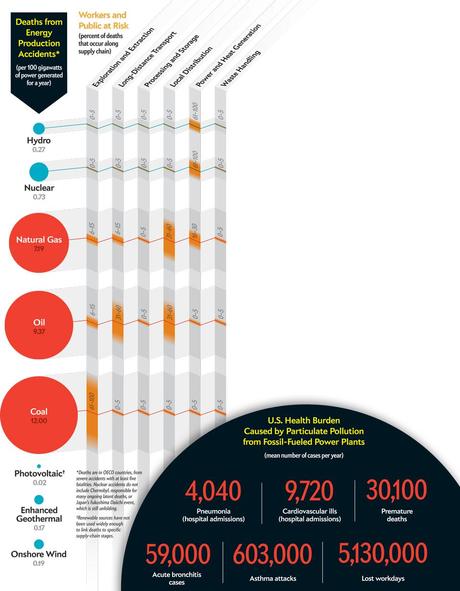Deadly accidents involving nuclear reactors, oil rigs and coal mines in recent months remind us that all forms of energy generation carry risks. In developed countries, coal is the most hazardous (bottom left), according to the Paul Scherrer Institute in Switzerland, which studied more than 1,800 accidents worldwide over nearly 30 years. For coal, mining tends to be the most dangerous step; for oil and gas, most accidents occur during distribution; and for nuclear, generating plants are on the hot seat (orange bars).
Developing nations tend to have higher fatality rates, experts say (although reporting is less comprehensive, so no numbers are shown). “Regulations may be less strict,” explains Peter Burgherr, head of technology assessment at the energy systems analysis laboratory at the institute. “Working conditions are also poorer,” and less mechanization means more people are doing manual labor in harm’s way.
The lion’s share of human costs, however, comes not from accidents but from pollution, which makes fossilfuels the most dangerous form of energy generation (below). As Burgherr notes, “People are often not aware of what is happening to them in daily life.”
— Mark Fischetti
 (click on image (or click here) to see a larger version of the infographic)
(click on image (or click here) to see a larger version of the infographic)
Quelle: Scientific American
Developing nations tend to have higher fatality rates, experts say (although reporting is less comprehensive, so no numbers are shown). “Regulations may be less strict,” explains Peter Burgherr, head of technology assessment at the energy systems analysis laboratory at the institute. “Working conditions are also poorer,” and less mechanization means more people are doing manual labor in harm’s way.
The lion’s share of human costs, however, comes not from accidents but from pollution, which makes fossilfuels the most dangerous form of energy generation (below). As Burgherr notes, “People are often not aware of what is happening to them in daily life.”
— Mark Fischetti
 (click on image (or click here) to see a larger version of the infographic)
(click on image (or click here) to see a larger version of the infographic) Quelle: Scientific American


